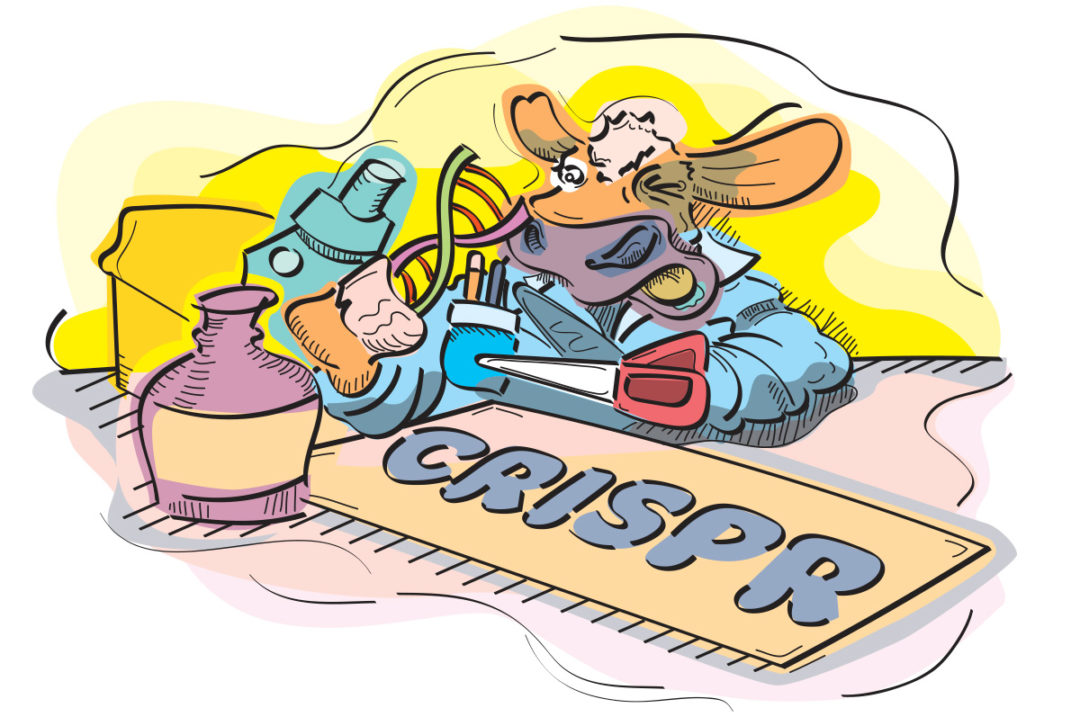The global demand for sustainable and resilient livestock systems has never been more pressing due to ever-increasing population growth and associated demand for animal-sourced protein. Part of the challenge to meet these demands will be accomplished using our current dairy breeding programs, which remain the cornerstone of genetic improvement for milk production and animal viability. These programs rely on incremental and cumulative genetic gains through selective breeding and assisted reproductive techniques such as cloning, embryo transfer (ET) and artificial insemination (A.I.). In more recent years, advances in genome sequencing and genotyping have enabled the commercial use of genomic selection in dairy cattle in the U.S., New Zealand and Europe. The integration of these resources has served to expedite and amplify genetic progress in dairy cattle for developed economies.
Looking ahead lies the imperative to select livestock that are not only more productive but also better equipped to withstand the challenges posed by pathogens and changing climatic conditions of local production environments. Traditionally, combating cattle diseases has relied on measures such as biosecurity and vaccination, which are strategies not available to dairy producers on a global basis. Sometimes, producers in more challenging climates have also turned to crossbreeding to breed more resilient animals. While these strategies have short-term success, they fall short of providing complete protection against many infectious agents. Challenges like these are further exacerbated by climate change, especially when heat-mediated stress leads to increased susceptibility to infectious disease.
Thus, now more than ever, farmers need to leverage every tool available to them to breed dairy animals that thrive in their production environment. Precision genetics needs to be at the forefront of those solutions used to meet local food security challenges. Of the new technologies to better manage livestock genetics, genome editing is arguably the next logical advancement of breeding tools that can establish outcomes whereby genetics potential is matched to environment, while avoiding the pitfalls of lost production capabilities often experienced with crossbreeding for adaptive traits.
Unlike genetically modified organisms (GMOs), which involve the incorporation of entirely new and sometimes foreign genetic material, genome editing offers unprecedented opportunities to make highly specific alterations in the genetic code of animals that can be indistinguishable from those found naturally in cattle. This level of precision crossbreeding provides unique opportunities to address breeding for valuable traits related to animal well-being and health not found in genomic indexes of selection.
How are animals gene edited?
Breeding animals with the aid of genome-editing tools involves several critical steps. The first step is to identify which trait is being “crossed” into an animal’s genome. The traits of interest are most likely those determined by breed associations, leading breeders or breeding companies that are or will be in demand in the genetics marketplace.
Next, the actual DNA sequence for the gene or genome location that affects this trait would have to be known. For example, we know that deleting a single DNA letter in the genetic code for the gene known as prolactin receptor can transform a dairy cow to be resilient to long-term heat stress. So if one wanted to breed tropically adapted Holsteins, a gene editing tool like CRISPR/Cas9 (clustered regularly interspaced short palindromic repeats) would be designed to cut DNA letters in this gene at the same location as the deletion in DNA code found in nature.
The process to alter the genome and produce a live animal with the new trait requires that the gene-editing tools be introduced in exact amounts in specific cell types that can produce an animal. Thus, the process is not done on semen or live animals already on the ground, but rather it requires either single-cell embryos or cells that can be cloned into an animal. It should be noted: The timing of when to add the gene-editing tool can also be a factor.
There are many types of gene-editing tools. Currently, the most transformative breeding tools are based on the Nobel-prize winner CRISPR/Cas9 enzyme complex. Interestingly, CRISPR/Cas was discovered as a defense system in bacteria against the invading DNA of bacterial pests. This defense system was transformed in the laboratory to be a tool providing precise DNA cuts using an RNA-guided Cas9 protein (ribonucleotide protein or RNP complex) for any species with known genome sequence. Functioning like molecular scissors, this RNP complex induces cuts that are followed by prompt DNA self-repair of the treated cell or embryo. The cow has a reference genome sequence, so this allows us to design tools that can cut most anywhere in the bovine genome. This process is described in detail online.
Practical applications for producers
The first gene-edited bovine animal was produced in 2013, which involved using a gene-editing tool to disrupt a gene involved in controlling muscle growth and size. Effectively, the animal produced from the injected embryo had increased muscle mass compared to conventionally bred animals of Zebu origin. Likewise, the first experimental polled dairy animal was cloned from “horned cells” in 2015. The first experimental heat-tolerant Angus was born in Brazil in 2018 from cells of an animal bred for the temperate climate of Minnesota. Academic groups continue to make experimental animals, but these really are not accessible to producers until the specific trait made by gene editing is made available for commercialization after regulatory decisions for safe use.
The first gene-edited cattle to get such a decision were born in 2020, when heat-tolerant Angus animals of commercial value were produced. These animals received regulatory decisions in Brazil and the U.S., whereby it was determined these animals had equivalent risk for breeding and food consumption as conventionally bred animals. Most recently in August 2023, the first heat-tolerant registered Holstein was approved for conventional breeding and food use in Brazil. These landmark regulatory decisions have now positioned new breeding technologies like genome editing to have significant impact in better equipping cattle to combat diseases and climate change without the loss of production gains obtained from decades of selection.
After more than 10 years of experimental breeding by gene editing, and as more and more animals enter commercial status, the first examples of single-gene traits for heat tolerance and disease resilience have demonstrated proven outcomes. The most promising gene-editing target to mitigate heat stress in highly productive, temperate taurine cattle is prolactin receptor (PRLR), which when truncated (or shortened) as described above causes SLICK. Animals harboring at least a single SLICK allele exhibit a distinct short and sleek hair coat phenotype referred to as the "slick phenotype." Rising global temperatures or tropical environments have a major detrimental impact on the most productive cattle breeds, particularly affecting animal productivity due to heat stress. Heat stress can compromise many facets of normal physiology including immunity and overall health, which has been shown to cause non-adapted cattle to be more susceptible to diseases. Now, there is also supporting evidence that SLICK mutations mitigate the detrimental effects of heat stress on milk yield and calving intervals. The positive effects linked to the SLICK-associated phenotype have prompted efforts to introduce the SLICK1 allele through crossbreeding into dairy cattle populations in Florida, Puerto Rico and New Zealand.
Relative to edits that directly impact animal health, there was a recent breakthrough to improve disease resilience by gene editing in cattle by researchers at U.S. Meat Animal Research Center in Clay Center, Nebraska. This case involved using gene editing to significantly decrease susceptibility to bovine viral diarrhea virus (BVDV). BVDV stands as a prominent worldwide cause of morbidity and distress among cattle populations, so the genome alteration introduced into a cloned dairy animal was shown to inhibit infection with no discernible effects on animal physiology during the first 20 months of life. This innovative approach holds the potential to elevate animal welfare standards and conceivably reduce the need for antibiotics, as BVDV infections are known to increase overall risk of secondary bacterial diseases in calves. This work also marks the inaugural instance of a breeding solution based on gene editing in cattle that reduced the impact of a major viral disease.
One last category of traits that is worth mentioning from the single-gene target model are those that eliminate the need for management practices that can be painful. These practices are based on either disbudding or dehorning practices to reduce injury risks to both cattle and farmers. An alternative to eliminate these management practices is to increase selection pressure on polled animals to increase the allele frequency in the dairy breeds. However, the low genetic merit of most existing polled sires combined with inbreeding challenges and the commodity nature of semen sales in the dairy industry has hindered the widespread adoption of this approach. Hence, gene editing to produce high-genetic-merit polled sires is an innovative approach that offers a more humane and efficient approach to improve dairy cattle welfare while maintaining productivity. As of late June 2023, polled dairy animals of commercial value and bred by gene editing are still not on the market; nevertheless, the first polled Wagyu cloned from “polled-edited” bovine embryonic stem cells were born in 2023 and should be commercialized soon.
These examples illustrate the potential of genome editing to genetically improve cattle by editing a single target in the genome. The real power of gene editing to be leveraged on a commercial scale will require editing multiple regions of the genome in a single generation. In order to stack traits and introduce variants affecting quantitative traits requires a more complicated editing approach to introgress multiple changes in the genome in a single cell treatment. It is particularly relevant for addressing disease resilience, as these types of traits usually involve multiple genes, necessitating several genomic changes to be replicated.
Widespread acceptance
Over the course of the past decade, endeavors in the field of animal gene editing have provided us with several clear insights. In countries where food security is a top priority and there exists a greater need for increased food production, the benefits offered by gene editing may lead to increased public acceptance of animals generated through this breeding technique. Also, it has been observed that gene-editing applications in livestock to address challenges related to welfare, health and sustainability are more likely to have wider public acceptance. To harness the full potential of gene editing in animal breeding, research should also continue on identifying genetic variants affecting traits of interest. Major variants with significant economic impact are still relatively limited. Gene editing has often involved disrupting single genes, but the true potential lies in precise genetic alterations, which can be maximized through editing multiple locations in the genome at once. These approaches are likely to play a key role in enhancing the ability of cattle to defend against pathogens.
Selective breeding, along with genetics, reproductive-assisted technologies and genomics have significantly impacted cattle production, yielding substantial benefits for animals, farmers and consumers. The next steps in animal breeding evolution will involve complementation by gene editing, which enables the precise modification of the DNA and rapid introduction of new traits. This process allows breeders to accelerate genetic gains, draw on genetic variation from other populations and species, and incorporate beneficial alleles for better health and well-being. Hence, new breeding technologies like genome editing are now poised to have significant impact in better equipping cattle to combat diseases and climate change without the loss of production gains obtained from decades of selection.











